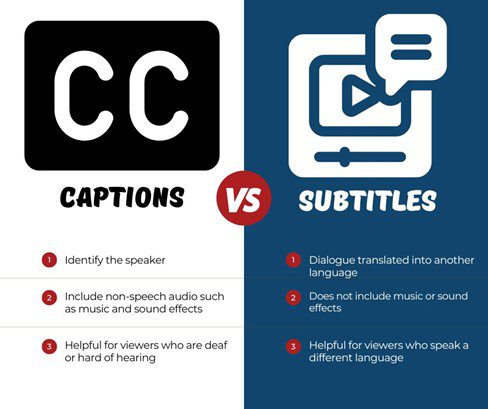Learn the difference between closed captions vs subtitles so you can better understand which is best suited for your video project..

Whether they’re scrolling for entertainment or searching for how-tos on YouTube, 50% of people report watching videos with captions or subtitles. While both perform similar roles and can improve viewer engagement, video captions and subtitles have specific use cases. In this article, we’ll explore the difference between closed captions vs subtitles so you can better understand which is best suited for your video project.
Is there a difference between captions vs subtitles?
Yes—captions and subtitles have different purposes and serve distinct audiences. For example, captions are usually more descriptive than subtitles and include sound effects, speaker identification, and other auditory information. On the other hand, subtitles are a textual representation of the dialogue in a video.

What are captions and when should you use them?
Captions are descriptions of the video audio features. They may include dialogue, music, and sound effects. Video captions typically appear at the bottom of the video as white text on a dark background. Captions make video content more accessible and easier to understand.
Open captions
Have you ever seen a movie where the characters suddenly start speaking a different language? Then you’ve likely seen open captions appear on the screen.
Open captions refer to captions that are part of the video track and are visible to all viewers. They are part of the video itself, so viewers do not need to figure out how to turn them on.
Open captions are often used for informational videos that are to be widely distributed to a diverse audience. A workplace training video, for example, may use open captions to maximize accessibility.
Closed captions
Closed captioning is the most common type and can be toggled on and off at will by the user. On social media and video-sharing platforms such as YouTube, a button is typically embedded in the media player labeled “CC.” When the viewer wants to see the captions, they can do so by clicking the CC button.
Closed captions are often auto-generated, meaning the video-sharing platform uses AI to create captions. While auto-generated captions are helpful in a pinch, they are often inaccurate and typically lack readability features such as punctuation.
To ensure viewers get the maximum benefit from video captions, many creators hire a professional transcriptionist to create closed captioning.
Why do viewers prefer to use captions?
Here are a few reasons viewers may choose to enable captions:
- Deaf or hard-of-hearing viewers use captions to follow along without missing any vital details.
- Many viewers choose to enable subtitles simply because they like being able to read along.
- Captions are helpful in situations when a viewer may want to avoid turning up the volume on their device, such as in a shared space.
- Language learners may choose to enable video captions to aid their understanding of dialogue, especially when spoken quickly or heavily accented.
Why invest in closed captioning?
Make your video more accessible.
With quality captions, your video will be accessible to deaf and hard-of-hearing viewers. Making provisions for your deaf and hard-of-hearing viewers is more than a kind gesture—it significantly improves their quality of life.
Broaden your video’s reach
Captioning is a simple accessibility feature that helps viewers from all walks of life engage with your content. By including video captions, you’re sure to attract more viewers.
Help educate viewers
Captions are commonly used by those who are using videos to learn languages. Generally speaking, it’s easier to understand written language than spoken. Therefore, providing captions is extraordinarily helpful for language learners.
Boost your SEO
Well-captioned videos are great for SEO. Search engines can’t “watch” a video, but they can detect text in your captions. So including a few keywords in your captions can help audiences find your videos more easily.
Create a better user experience
Captions help viewers engage with your video, no matter who they are or where they are. With captions, viewers can easily watch without headphones or follow along despite a language barrier. (Considering there are more than 500 million Spanish speakers in the world, Spanish transcription sounds like a good idea!)
Tips for successful captioning
When learning how to caption your videos, there are a few things to consider. So here are a few tips for successful captioning:
Don’t rely on auto-generated captions.
It may seem easier to let your video-sharing platform do the captioning, but auto-generated captions aren’t very accurate, and caption mistakes make things more difficult for viewers. Edit your captions to ensure they’re accurate and readable.
Do include the following:
- All dialogue and narration, including speech effects such as stuttering
- Song identification with artist name and lyrics
- Identification of off-screen speakers
- Audio descriptions of sound effects relevant to the story (e.g., explosions)
Don’t include the following:
- Every single word or sound effect if it’s impractical to do so (e.g., in areas of fast-paced dialogue, you may leave out repeated words.)
- Text that’s already on-screen (e.g., signage at a protest)
Maximize readability.
To ensure your text can be easily read by audiences, make sure you follow grammar and spelling conventions. Take timing into consideration as well—captions should stay on-screen for at least two seconds. In addition, lines shouldn’t exceed 37 characters, and captions should not be longer than two lines.
Ensure the captions match the video.
Captions should reflect what’s happening on screen as much as possible. That may mean including ellipses to account for pauses in speech, adjusting the timing of the caption to coincide with the video, and including descriptions of sound effects.
What are subtitles and when should you use them?
While captions are meant to assist those who can’t hear the audio, subtitles are intended to help bridge a language gap between the viewer and the video using on-screen text. Subtitles are captions translated into a different language.
For example, if you’re a native English speaker who would like to enjoy a Spanish film in its original language—that is, a non-dubbed version—you may choose to watch it with English subtitles. That means you’ll hear the original actors’ voices and intonations while still understanding what’s happening.
Open subtitles (hard subtitles)
Hard subtitles, or open subtitles, are added to the video itself and appear in-frame. That means the viewer doesn’t need to do anything to turn them on.
However, because it’s “burned” into the video, open subtitles only allow for translation into one language. This may be suitable in certain situations; for example, a Polish video being distributed to the English market.
Closed subtitles (pre-rendered)
Similar to closed captions, closed subtitles can be turned on and off by the viewer. On a technical level, they’re encoded as a separate video file that’s laid over the original.
With closed subtitles, it’s possible to add multiple language options to a single video. Videos made for a diverse international audience typically contain closed subtitles in several of the world’s widely-spoken languages—and with enough translators, there is no end to the number of translations you could provide using closed subtitles.
Soft subtitles
Soft subtitles are similar to closed subtitles. But rather than existing as a video overlay, soft subtitles live in a separate file that runs alongside the video. “Fansubs,” or fan-created subtitles, are typically soft subtitles.
Is subtitling a worthwhile investment?
If your video is intended for an international audience, subtitling is a no-brainer—subtitling may be the difference between thousands or millions of views. That said, subtitling can get pricey. So here are a few things worth considering:
Does your video have global appeal?
When deciding whether it’s worth investing in subtitles, ask yourself whether your videos have global appeal. For example, if you create video essays about life in American cities, it might not make sense to subtitle your videos. But if your video is about a famous telenovela, subtitles are a good move.
Do you live in an area with many speakers of other languages?
Another variable to consider is whether you want to appeal to speakers of other languages. If so, hiring translators to help you with subtitles may be a good idea.
For example, a channel that caters to the Los Angeles market may subtitle their shows in Spanish, Chinese, Tagalog, and Vietnamese to help make video content accessible to a broader audience.
Best tools for adding captions and subtitles to video
YouTube
If you’re looking for a free, all-in-one tool to add subtitles and captions YouTube is likely your best option. With the Subtitles/CC (Closed Captions) feature, you can upload transcripts in multiple languages or use YouTube’s auto-captioning tool. You can also customize font size and color, manipulate text placement, and review captions before they’re published.
Veed.io
Veed.io is an AI-powered subtitling and captioning platform that makes it easy to add subtitles to your videos. With its intuitive user interface, you can quickly upload a video and have subtitles automatically generated within minutes.
You also have the option of manually editing subtitles or exporting them in multiple formats before adding them back into your video. Veed.io also offers text-to-speech and voice recognition features to help you transcribe content quickly and accurately.
SpeakWrite
SpeakWrite is a great tool for ensuring the accuracy of subtitles and captions. SpeakWrite uses 100% human transcription services and provides accurate, affordable, high-quality transcripts of audio or video files that can then be used to create nearly-perfect captions and subtitles.
Human transcription is notably more accurate than AI-powered transcription or speech-to-text, so if you need captions and subtitles that are true to the source material, SpeakWrite is the best choice.
Ready to level up your video content with transcription services?
Now that you understand the difference between closed captions and subtitles, you can make an informed choice about which approach is best for your video project.
If you’re looking for professional transcriptionists to help you create closed captions or subtitles for your video content, SpeakWrite can help. We’re a full-service transcription agency that connects businesses with professional transcription with lightning-fast turnaround times.
Have a free trial on us and see how transcription services can transform your video content today.




